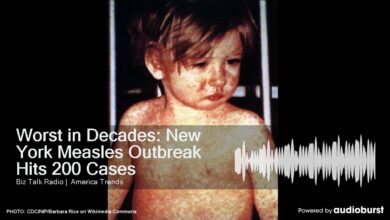
The danger in delaying or skipping vaccinations for children is a serious concern, impacting not only individual health but also the well-being of entire communities. This crucial discussion delves into the potential consequences of missed shots, examining everything from the immediate health risks to long-term outcomes, the ripple effect on herd immunity, and the critical role of public health campaigns in educating and reassuring parents.
Delayed or missed vaccinations expose children to a higher risk of contracting preventable diseases, ranging from the common cold to life-threatening illnesses. Vulnerable populations, like infants and those with weakened immune systems, are particularly susceptible. Understanding the potential severity of these diseases and the importance of timely vaccinations is paramount.
The Impact of Delayed/Skipped Vaccinations on Individual Children
Delaying or skipping vaccinations can have serious and potentially life-altering consequences for children. These preventable diseases, once prevalent, are now largely controlled through widespread vaccination programs. Choosing to forgo these protections exposes children to significant health risks, not just for themselves but also for those around them.Children’s immune systems are still developing, and vaccinations are crucial in building their defenses against harmful pathogens.
Delaying or skipping vaccinations weakens this defense, leaving children vulnerable to a range of potentially severe illnesses. The consequences can extend beyond immediate health issues, impacting their overall well-being and future development.
Potential Health Consequences
Children who delay or skip vaccinations are at increased risk of contracting vaccine-preventable diseases. These diseases can lead to a variety of complications, including severe infections, long-term disabilities, and even death. The severity of the illness can vary significantly depending on the specific disease and the child’s overall health status.
Risks for Vulnerable Populations
Certain populations, such as infants and immunocompromised children, are particularly vulnerable to the dangers of vaccine-preventable diseases. Infants, with their developing immune systems, are especially susceptible to serious complications. Immunocompromised children, whose immune systems are weakened by underlying conditions, face a higher risk of severe infections and complications. Early childhood is a critical time for development, and the impact of severe illness can be profound.
Comparison of Vaccine-Preventable Diseases
| Disease | Severity | Potential Complications |
|---|---|---|
| Measles | High | Pneumonia, encephalitis, death |
| Mumps | Moderate | Meningitis, deafness, orchitis (inflammation of the testicles) |
| Rubella | High (especially for pregnant women) | Congenital rubella syndrome, causing birth defects in unborn children |
| Polio | High | Paralysis, respiratory failure, death |
| Diphtheria | High | Heart problems, breathing difficulties, death |
| Tetanus | High | Muscle spasms, respiratory failure, death |
| Pertussis (Whooping Cough) | Moderate to High | Pneumonia, seizures, brain damage, death, especially in infants |
| Hepatitis B | Moderate to High | Liver damage, liver cancer |
Community Impact of Delayed Vaccinations
A significant concern is the increased risk of outbreaks in communities where vaccination rates are low. When a large portion of the population is not vaccinated, it creates an environment where vaccine-preventable diseases can spread rapidly. This poses a risk to everyone, including those who have been vaccinated, and those who cannot be vaccinated for medical reasons. Communities with low vaccination rates have experienced outbreaks of preventable diseases in recent years, highlighting the critical importance of vaccination programs.
“Vaccination is a cornerstone of public health, protecting individuals and communities from devastating diseases.”
A recent outbreak of measles in a previously well-vaccinated region underscores the importance of high vaccination rates in preventing disease transmission.
The Ripple Effect on Community Health

A decline in vaccination rates doesn’t just impact individual children; it creates a ripple effect that weakens the entire community’s health. Herd immunity, a crucial shield against contagious diseases, becomes compromised when a significant portion of the population isn’t vaccinated. This vulnerability opens the door to outbreaks, straining public health resources and potentially jeopardizing the health of many more.The concept of herd immunity relies on a high enough proportion of the population being immune to a disease, either through vaccination or prior infection.
This immunity creates a protective barrier, making it difficult for the disease to spread. When vaccination rates fall, this protective barrier weakens, increasing the risk of outbreaks. For example, measles outbreaks have been observed in communities with low vaccination coverage, highlighting the direct link between reduced vaccination rates and the potential for widespread disease transmission.
Impact on Herd Immunity
Decreased vaccination rates directly undermine herd immunity. When fewer people are vaccinated, the proportion of the population immune to a disease falls below the critical threshold needed to prevent its spread. This creates a susceptible population, vulnerable to outbreaks. Measles, in particular, is highly contagious, and even a small number of unvaccinated individuals can trigger an outbreak.
This vulnerability is especially concerning for vulnerable populations, such as infants too young to be vaccinated, immunocompromised individuals, or those with chronic health conditions.
Potential for Outbreaks and Their Impact
A decline in vaccination rates significantly increases the likelihood of outbreaks. Outbreaks can overwhelm public health resources, diverting vital personnel and funding from other essential health services. This strain on resources can lead to delayed or inadequate responses to other health concerns, impacting the overall well-being of the community. The economic burden of outbreaks, including lost productivity due to illness and healthcare costs, can be substantial, impacting individuals, families, and the economy as a whole.
Measures to Prevent Outbreaks in Communities with Low Vaccination Rates
To mitigate the risk of outbreaks in communities with low vaccination rates, targeted interventions are crucial. Public health officials often implement strategies such as community outreach programs, educational campaigns, and vaccine clinics to encourage vaccination. These initiatives aim to address misinformation and build trust in the safety and efficacy of vaccines. Furthermore, enhanced surveillance systems are vital to quickly identify and contain outbreaks.
Early detection allows for swift interventions, preventing further spread.
Strategies to Maintain Vaccination Rates and Prevent Outbreaks
| Strategy | Description |
|---|---|
| Community Outreach | Engaging with community leaders, parents, and healthcare providers to build trust and address concerns about vaccines. |
| Educational Campaigns | Disseminating accurate information about the benefits and safety of vaccines through various channels, including social media, community events, and healthcare settings. |
| Vaccine Clinics | Making vaccines readily accessible through convenient and accessible clinics, addressing logistical barriers to vaccination. |
| Addressing Misinformation | Actively countering misinformation and false claims about vaccines through evidence-based information and credible sources. |
| Enhanced Surveillance | Implementing robust surveillance systems to quickly detect and respond to outbreaks, allowing for timely interventions and preventing further spread. |
The Role of Misinformation and Public Health Campaigns: The Danger In Delaying Or Skipping Vaccinations For Children
The decision to vaccinate children is a personal one, often weighed against perceived risks and anxieties. However, misinformation and distrust in the scientific consensus surrounding vaccines have significantly contributed to declining vaccination rates. This has far-reaching consequences, impacting not only individual children but also the broader community’s health. Understanding the nature of this misinformation and the strategies employed by public health organizations is crucial for fostering informed decision-making.Public health campaigns play a vital role in countering misinformation and promoting vaccination.
These campaigns aim to educate the public, address concerns, and build trust in the safety and efficacy of vaccines. Effective campaigns are crucial to reversing the trend of vaccine hesitancy and ensuring herd immunity, safeguarding vulnerable populations.
Common Misconceptions and Misinformation
Misinformation surrounding childhood vaccinations often stems from fear-mongering, conspiracy theories, and the spread of unsubstantiated claims. A key misconception is the false link between vaccines and autism, a claim repeatedly debunked by numerous scientific studies. Other concerns include perceived adverse effects, the complexity of vaccine schedules, and the perceived necessity of multiple doses. These concerns, even when unfounded, can significantly influence parental decisions.
The internet’s ease of sharing information, both accurate and inaccurate, contributes to the rapid spread of misinformation.
Strategies Employed by Public Health Organizations
Public health organizations employ a multifaceted approach to combat vaccine hesitancy and misinformation. This involves targeted communication campaigns, collaboration with healthcare providers, and fostering trust within communities. They emphasize the importance of evidence-based information, dispelling myths with scientific facts, and building rapport with communities. Furthermore, they address concerns about safety and efficacy through transparent communication channels.
Key Components of Effective Public Health Campaigns
- Clear and Concise Messaging: Campaigns must present information in a straightforward and easily understandable manner. Avoid jargon and complex scientific terms. Emphasize the benefits of vaccination for individual children and the community as a whole. For example, a campaign should clearly explain the connection between vaccination rates and disease outbreaks, like measles or whooping cough.
- Multi-Channel Communication: Reaching diverse audiences requires utilizing various platforms. This includes social media, community events, and partnerships with healthcare providers. For example, a campaign might use social media to share infographics on the effectiveness of vaccines, and partner with local pharmacies to host vaccination clinics.
- Building Trust and Credibility: Establishing trust is paramount. Public health campaigns should feature credible sources, including medical professionals and public health experts. For example, showcasing testimonials from parents who have successfully vaccinated their children and who experienced positive outcomes can significantly influence parental decisions.
- Addressing Parental Anxieties: Emphasize the importance of open communication and actively listen to parental concerns. Provide resources for further information and facilitate access to healthcare providers for personalized consultations. This approach will allow parents to ask questions, share concerns, and gain clarity.
Debunking Myths and Addressing Parental Anxieties
Addressing parental anxieties about vaccinations requires a compassionate and evidence-based approach. Healthcare providers should be trained to address these concerns with empathy and factual information. Furthermore, educational materials should clearly explain the benefits and safety of vaccines. For example, providing information about the rigorous testing and approval processes for vaccines can address concerns about safety. Addressing parental anxieties directly and providing access to reliable information can empower parents to make informed decisions about their children’s health.
Example of a Public Health Campaign Table
| Campaign Component | Description | Example |
|---|---|---|
| Target Audience | Identifying the specific demographic being targeted (e.g., parents of young children, healthcare providers). | Parents of children aged 0-2 years. |
| Messaging Strategy | Developing a clear and concise message about the benefits of vaccination. | Highlighting the reduced risk of infectious diseases in communities with high vaccination rates. |
| Communication Channels | Selecting appropriate platforms to reach the target audience (e.g., social media, community events, print media). | Social media campaigns, community health fairs, and partnerships with schools. |
| Evaluation Metrics | Tracking the effectiveness of the campaign by measuring vaccination rates and public awareness. | Monitoring vaccination rates before and after the campaign and comparing data to identify improvements. |
The Importance of Vaccination Schedules and Adherence

Following the recommended vaccination schedule is crucial for a child’s health and well-being. It’s like building a strong fortress of immunity, layer by layer, with each vaccination providing a crucial shield against specific diseases. Proper timing is essential, as the body’s response to vaccines is optimized when given at the recommended intervals.Vaccination schedules are meticulously designed based on extensive research and clinical trials.
They consider the developmental stages of a child’s immune system, ensuring the most effective and safest protection possible. Adherence to this schedule isn’t just about individual protection; it plays a vital role in community health, preventing outbreaks and safeguarding vulnerable populations.
Benefits of Timely Vaccination
Vaccination schedules are designed to provide optimal protection against a range of infectious diseases. Timely vaccinations build a robust immune response, minimizing the risk of severe illness and long-term health complications. The protective effect of vaccines is most effective when administered according to the schedule. This is due to the specific timing of exposure to antigens, which allows the immune system to develop the necessary antibodies to combat the disease.
Protection from Severe Illness
Adherence to the vaccination schedule is directly linked to a child’s protection from severe illness. Vaccines train the immune system to recognize and fight specific pathogens, preventing the onset of potentially debilitating diseases. For instance, the measles vaccine prevents the development of complications like pneumonia, encephalitis, and even death. Similarly, the polio vaccine protects against paralysis, a devastating outcome of the disease.
Potential Risks of Deviating from the Schedule
Deviating from the recommended vaccination schedule can significantly compromise a child’s immunity and increase their risk of contracting vaccine-preventable diseases. Delaying or skipping doses weakens the body’s ability to mount an effective immune response, potentially leaving the child vulnerable to infections. This is particularly critical during childhood, when the immune system is still developing. Furthermore, delaying or skipping vaccines can create gaps in protection, increasing the likelihood of disease transmission within the community.
For example, if a child is not vaccinated against whooping cough, they are at risk of contracting the disease and potentially spreading it to others, especially those who are too young or have compromised immune systems.
The Impact of Missed or Delayed Doses
Missed or delayed doses can disrupt the chain of immunity in the body. The immune response may not be as robust or timely, and the protection from certain diseases may be significantly reduced. This is especially concerning for diseases like measles, mumps, and rubella (MMR), which can lead to severe complications or even death. The impact of missing a dose can be further amplified if subsequent doses are also missed.
The protective effects built up by previous vaccinations may not be fully realized, leaving the child vulnerable to infections.
Delaying or skipping childhood vaccinations is seriously risky, putting kids at risk for preventable diseases. While advancements like the potential of ttp399 future type1 diabetes pill offer hope for treating conditions like type 1 diabetes, it’s crucial to remember that vaccines are our best defense against widespread illnesses. We need to continue prioritizing vaccination schedules for optimal child health.
Importance of Consistency, The danger in delaying or skipping vaccinations for children
Consistency in adhering to the vaccination schedule is crucial for building a comprehensive defense against infectious diseases. The recommended doses and intervals are carefully calibrated to maximize the immune response. Consistency helps establish the optimal level of immunity, safeguarding the child from potentially life-threatening complications. Disruptions in the schedule can reduce the overall effectiveness of the vaccination program.
The effectiveness of the vaccine relies on the consistent exposure to the antigens in a specific timeline. The body’s immune system is trained and developed to recognize and fight the pathogens.
The Connection Between Vaccination and Public Health Infrastructure
Vaccination isn’t just about individual protection; it’s a cornerstone of public health, deeply intertwined with the infrastructure that supports community well-being. Reliable access to vaccines, coupled with robust healthcare systems and targeted programs, is crucial for maintaining herd immunity and safeguarding populations from preventable diseases. This interconnectedness ensures that the benefits of vaccination extend beyond individual cases to protect the entire community.A strong public health infrastructure is vital for effective vaccination programs.
This includes a network of healthcare providers capable of administering vaccines, maintaining adequate vaccine supplies, and educating the public about the importance of immunization. The availability of these resources and the commitment to their maintenance are directly correlated with the success of vaccination efforts in safeguarding population health.
Importance of Reliable Access for All Children
Ensuring all children have reliable access to vaccines is paramount for community health. Disparities in access can lead to pockets of vulnerability within populations, potentially hindering the overall effectiveness of vaccination programs. These disparities can manifest as geographical barriers, financial constraints, or a lack of awareness about vaccination schedules and their importance.
Role of Healthcare Providers in Promoting and Administering Vaccinations
Healthcare providers play a critical role in vaccination efforts. They are not only responsible for administering vaccines but also for educating parents and children about the benefits and safety of vaccination. Their role extends to dispelling misinformation and building trust in the immunization process. Qualified healthcare providers act as essential liaisons between the public and vaccination programs, fostering a healthy and informed approach to immunization.
Significance of Vaccination Programs in Low-Resource Communities
Vaccination programs are particularly significant in low-resource communities. These communities often face unique challenges, such as limited access to healthcare facilities, transportation issues, and financial barriers. Targeted programs and initiatives are crucial in addressing these specific needs and ensuring that all children, regardless of their socioeconomic background, have access to essential vaccinations. Dedicated efforts and resource allocation are vital in reaching and supporting these communities to maximize the impact of vaccination programs.
Delaying or skipping childhood vaccinations is a serious risk. While the connection isn’t immediately obvious, research into the potential role of fungi in Crohn’s disease, like fungi role in crohns disease , highlights the complex interplay of factors affecting our health. Ultimately, prioritizing vaccination schedules protects our children’s immune systems from preventable diseases.
Factors Influencing Access to Vaccination Services
| Demographic Group | Factors Influencing Access | Examples |
|---|---|---|
| Low-income families | Financial constraints, limited access to transportation, lack of awareness about vaccination programs | Families facing high costs for transportation, childcare, or clinic visits may struggle to access vaccinations. |
| Rural communities | Geographical remoteness, limited availability of healthcare providers, lack of transportation options | Children in rural areas may have longer travel times to vaccination clinics, potentially missing scheduled appointments. |
| Immigrant families | Language barriers, cultural beliefs, lack of familiarity with the local healthcare system, and possible distrust of the healthcare system | Language barriers can impede effective communication between parents and healthcare providers about the importance of vaccination. |
| Children with disabilities | Coordination challenges, access to specialized healthcare services, lack of appropriate accommodations at vaccination centers | Children with specific needs may require additional support during vaccinations to ensure a smooth and safe process. |
| Marginalized groups | Social stigma, discrimination, lack of community support, and a history of poor experiences with the healthcare system | Certain social or cultural factors can influence vaccination decisions and create barriers to accessing the necessary services. |
Long-Term Health Outcomes
Delaying or skipping vaccinations can have devastating long-term consequences for children’s health. These preventable diseases, when contracted, can lead to significant complications that impact their physical and cognitive development, potentially affecting their quality of life for years to come. The consequences extend beyond the individual child, impacting the community’s overall health infrastructure.The body’s immune system is crucial for defending against harmful pathogens.
Vaccinations train this system to recognize and fight specific diseases without the actual illness. When vaccinations are delayed or missed, the immune system remains vulnerable, leaving children susceptible to serious and potentially lifelong health problems. This underscores the importance of adhering to recommended vaccination schedules.
Chronic Health Problems from Vaccine-Preventable Diseases
Vaccinations effectively protect against a range of infectious diseases. Failure to vaccinate can lead to these diseases manifesting in severe forms, resulting in long-term complications and chronic health problems. For example, measles, a highly contagious viral infection, can cause encephalitis (inflammation of the brain) in some cases. This can lead to permanent neurological damage, impacting cognitive function and causing long-term disability.
Similarly, whooping cough (pertussis) can cause severe respiratory complications in infants and young children, potentially leading to long-term breathing problems.
Delaying or skipping childhood vaccinations is a serious concern. It weakens a child’s immune system, increasing their vulnerability to preventable diseases. While we’re on the topic of health, it’s important to understand conditions like body-focused repetitive behaviors (BFRBs), which can sometimes be related to stress or anxiety. For more information, check out this helpful resource on what to know about body focused repetitive behaviors bfrbs.
Ultimately, prioritizing vaccinations is crucial for a child’s overall well-being and protection against serious illnesses.
Quality of Life for Vaccinated and Unvaccinated Children
The quality of life for children significantly differs based on vaccination status. Children who receive vaccinations are protected from potentially debilitating diseases. This protection allows them to focus on development and growth without the constant threat of serious illness and the associated physical and emotional toll. Conversely, unvaccinated children face a heightened risk of contracting vaccine-preventable diseases.
These diseases can result in hospitalization, long-term health complications, and limitations in their activities, directly impacting their quality of life.
Potential Long-Term Effects of Vaccine-Preventable Diseases
The table below Artikels potential long-term health effects of various vaccine-preventable diseases. It’s crucial to recognize the profound impact these diseases can have on a child’s future well-being. Note that the severity and specific long-term effects can vary significantly based on individual factors.
| Disease | Potential Long-Term Effects |
|---|---|
| Measles | Encephalitis (brain inflammation), hearing loss, pneumonia, long-term neurological problems, developmental delays. |
| Mumps | Deafness, meningitis (inflammation of the membranes surrounding the brain and spinal cord), encephalitis, swollen testicles (or ovaries), sterility. |
| Rubella (German Measles) | Congenital rubella syndrome (CRS) in the unborn child (leading to heart defects, cataracts, deafness, intellectual disability), miscarriage. |
| Polio | Paralysis, muscle weakness, breathing problems, and other debilitating conditions. |
| Whooping Cough (Pertussis) | Pneumonia, seizures, brain damage, breathing difficulties, long-term respiratory problems. |
Parental Concerns and Addressing Concerns
Many parents harbor legitimate concerns about vaccinating their children. Understanding these anxieties and providing evidence-based reassurance is crucial for fostering informed decision-making. These concerns often stem from a desire to protect their children and a natural hesitation towards medical interventions. Addressing these anxieties directly and transparently is key to building trust and encouraging vaccination.
Common Parental Concerns Regarding Vaccinations
Parental concerns about vaccinations often revolve around potential side effects, the perceived unnecessary nature of certain vaccines, and doubts about the overall safety of the vaccine schedule. Some parents worry about the potential for adverse reactions, such as fever, pain, or allergic reactions, even though these are typically mild and temporary. Others question the effectiveness of vaccines, particularly for conditions that seem uncommon in their communities.
Concerns about the ingredients in vaccines, often fueled by misinformation, are also prevalent.
Safety of Vaccines: Scientific Evidence
Extensive research and rigorous testing have established the safety of vaccines. Independent organizations, such as the Centers for Disease Control and Prevention (CDC) and the World Health Organization (WHO), meticulously monitor vaccine safety and efficacy. Millions of children have been vaccinated safely, and serious adverse events are extremely rare. Furthermore, rigorous scientific studies demonstrate that the benefits of vaccines far outweigh the risks.
For instance, the overwhelming scientific consensus supports the safety and effectiveness of the measles, mumps, and rubella (MMR) vaccine, despite historical and often unsubstantiated claims to the contrary.
Benefits of Vaccinations Outweighing the Risks
The benefits of vaccination programs are undeniable. Immunization protects not only the individual child but also the wider community. By building herd immunity, we safeguard vulnerable populations, such as infants too young to be vaccinated, or those with compromised immune systems. Vaccines prevent outbreaks of infectious diseases, reducing hospitalizations and fatalities. For example, the eradication of smallpox, a devastating disease, was a direct result of a global vaccination campaign.
Resources for Parents
This table provides valuable resources for parents with concerns about vaccinations. These resources offer accurate, evidence-based information and can help parents make informed decisions.
| Resource | Description | Website/Contact Information |
|---|---|---|
| Centers for Disease Control and Prevention (CDC) | Provides comprehensive information on vaccines, including safety data and recommendations. | www.cdc.gov |
| American Academy of Pediatrics (AAP) | Offers guidance on vaccine safety and schedules, tailored for pediatricians and parents. | www.healthychildren.org |
| World Health Organization (WHO) | Provides global perspectives on vaccination, including recommendations and resources for parents. | www.who.int |
| Local Health Departments | Offer information and support specific to local vaccination programs and concerns. | Search online for your local health department. |
The Impact on Healthcare Costs
Vaccinations aren’t just about individual health; they significantly impact the overall economic health of communities. The financial burden of vaccine-preventable diseases is substantial, impacting both individuals and society as a whole. Understanding these costs is crucial for appreciating the long-term benefits of vaccination programs.The cost of treating vaccine-preventable illnesses extends far beyond the immediate expenses of doctor visits and medications.
Chronic conditions resulting from these diseases can lead to years of ongoing medical care, including physical therapy, rehabilitation, and specialized treatments. These extended healthcare needs often strain individual budgets and require significant societal investment in public health infrastructure.
Economic Burden of Vaccine-Preventable Diseases
The economic burden of vaccine-preventable diseases encompasses a wide range of costs, including direct medical expenses and indirect costs such as lost productivity and reduced quality of life. Direct medical costs include hospitalizations, doctor visits, medications, and long-term care. Indirect costs, on the other hand, represent the economic impact of illness on individuals and society.
Financial Implications of Treatment Costs
Treating vaccine-preventable diseases often results in substantial financial burdens for individuals. The expenses associated with hospital stays, intensive care, and prolonged recovery periods can quickly deplete savings and create significant financial stress. For families, the financial strain can be devastating, potentially leading to lost wages and reduced access to essential resources.
Examples of Cost Reduction Through Vaccination Programs
Vaccination programs effectively reduce healthcare costs in the long run by preventing the onset of these diseases. By preventing the illness, individuals avoid the costs associated with diagnosis, treatment, and long-term complications. This translates into substantial savings for healthcare systems, allowing them to allocate resources more effectively. Public health agencies can redirect funds towards other critical areas like disease surveillance and preventative care, which further strengthens the health infrastructure.
Comparison of Costs: Vaccine Programs vs. Treatment of Diseases
The following table provides a simplified comparison of the costs associated with vaccine programs and the costs of treating vaccine-preventable diseases. This comparison highlights the significant cost-saving potential of proactive vaccination strategies. The numbers presented are illustrative and may vary depending on the specific disease and healthcare setting.
| Category | Cost of Vaccination Programs | Cost of Treating Vaccine-Preventable Diseases |
|---|---|---|
| Initial Vaccination Cost (per child) | $100 – $300 | $1,000 – $100,000+ (depending on severity and duration of illness) |
| Long-Term Care Costs (per case) | N/A | $10,000 – $1,000,000+ (depending on the severity of long-term complications) |
| Productivity Loss (per case) | N/A | $5,000 – $500,000+ (depending on the duration of illness and the affected individual’s role in the workforce) |
| Total Societal Cost | Minimal, when compared to the total societal cost of treating the disease. | Significant, including direct and indirect costs to individuals and the community. |
“A comprehensive vaccination program is a crucial investment in public health, not just a cost-saving measure. It safeguards individuals, strengthens communities, and ultimately contributes to a healthier and more prosperous society.”
Closing Notes
In conclusion, prioritizing childhood vaccinations is not just a personal choice; it’s a community responsibility. The potential risks associated with delaying or skipping vaccinations are substantial, impacting individual health, community well-being, and even straining public health resources. By understanding the science behind vaccination schedules, dispelling misinformation, and promoting open communication, we can safeguard the health and future of our children and maintain robust public health infrastructure.





